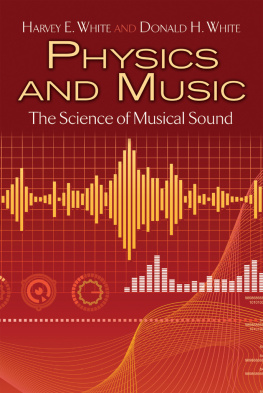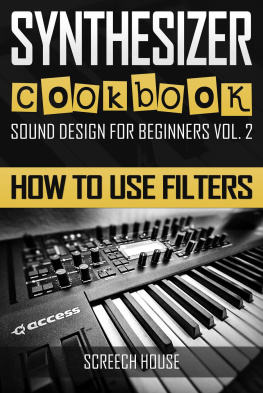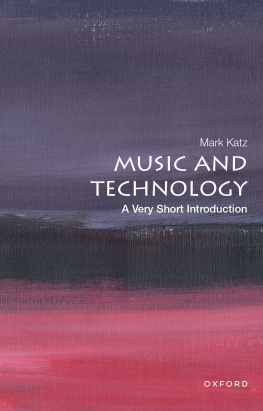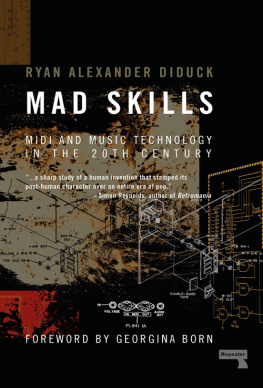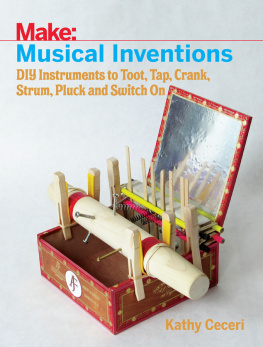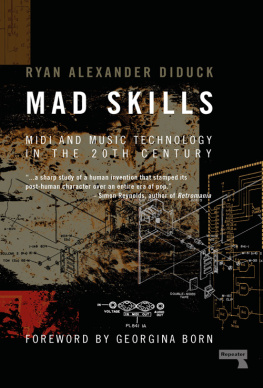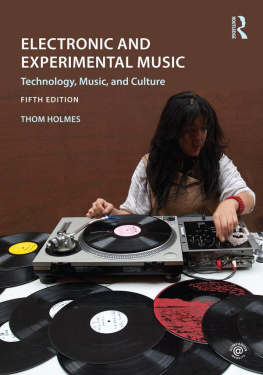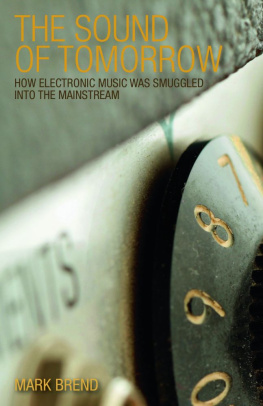The Synthesizer
The Synthesizer
A COMPREHENSIVE GUIDE TO UNDERSTANDING, PROGRAMMING, PLAYING, AND RECORDING THE ULTIMATE ELECTRONIC MUSIC INSTRUMENT
Mark Vail


Oxford University Press is a department of the University of Oxford. It furthers the Universitys objective of excellence in research, scholarship, and education by publishing worldwide.
Oxford New York
Auckland Cape Town Dar es Salaam Hong Kong Karachi
Kuala Lumpur Madrid Melbourne Mexico City Nairobi
New Delhi Shanghai Taipei Toronto
With offices in
Argentina Austria Brazil Chile Czech Republic France Greece
Guatemala Hungary Italy Japan Poland Portugal Singapore
South Korea Switzerland Thailand Turkey Ukraine Vietnam
Oxford is a registered trade mark of Oxford University Press in the UK and certain other countries.
Published in the United States of America by
Oxford University Press
198 Madison Avenue, New York, NY 10016
Mark Vail 2014
All rights reserved. No part of this publication may be reproduced, stored in a retrieval system, or transmitted, in any form or by any means, without the prior permission in writing of Oxford University Press, or as expressly permitted by law, by license, or under terms agreed with the appropriate reproduction rights organization. Inquiries concerning reproduction outside the scope of the above should be sent to the Rights Department, Oxford University Press, at the address above.
You must not circulate this work in any other form
and you must impose this same condition on any acquirer.
Library of Congress Cataloging-in-Publication Data
Vail, Mark.
The synthesizer : a comprehensive guide to understanding, programming, playing, and recording the ultimate
electronic music instrument / Mark Vail.
pages cm
Includes bibliographical references and index.
ISBN 978-0-19-539481-8 (alk. paper) ISBN 978-0-19-539489-4 (alk. paper) 1. Synthesizer (Musical
instrument)Instruction and study. 2. Electronic musicInstruction and study. I. Title.
MT723.V35 2013
786.7'419dc23 2013008727
1 3 5 7 9 8 6 4 2
Printed in the United States of America on acid-free paper
CONTENTS
W hen Bob Moog introduced the Moog modular synthesizer in the 1960s, it was the first new popularized instrument invented since Adolphe Sax created the saxophone in 1846. While almost a century separated these developments in musical technology, the efforts that led to the modern-day synthesizer were many. Pioneers such as Thaddeus Cahill, Leon Theremin, Friedrich Trautwein, Raymond Scott, Vladimir Ussachevsky, Paul Ketoff, Harald Bode, and many more each made important steps toward exploring the possibilities of sound sculpting by electronic means. Bob Moogs work, and the work of every other synth manufacturer, is built on the shoulders of those giants.
Even prior to formal education in the fields of engineering and physics, Bob devoted his time in his fathers basement workshop educating himself about the history and technology of electronic music. This early passion led to his double undergraduate degrees and to his PhD from Cornell University in Engineering Physics. He remained a student of both the technical rigors of engineering and the rich and varied history of electronic music throughout his career. His intertwined understanding informed his professional path; his path informed an industry.
At the Bob Moog Foundation we embrace the ultimate importance of music, science, and history education as a force to inspire children to blaze new paths. With Bobs life and careerand those of so many other synthesizer pioneersas our inspiration, we created Dr. Bobs SoundSchool to teach kids the science of sound. Waveforms, vibrations, pitch, amplitude, and the components of sound creation and transmission inform the students knowledge of basic physics. The concepts are also used to ignite their sense of curiosity, exploration, and creativity.
Through this book, Mark Vail is echoing Bobs very own sentiments of the importance of both technical and historical information as forces to true understanding of the vast and glorious world of sound synthesis. The thorough and methodical exploration laid forth in the following pages provides for an inspired path of learning, understanding, and creating. In particular, the section on controllers is something Bob would have felt to be of utmost importance. From the magical elegance of the Theremin to the then-unprecedented touch sensitivity of the little-known Eaton-Moog MTS keyboard to the touchpad on the Moog Voyager synthesizer, he was impassioned about the creation of new control interfaces for musicians; he saw them as the most viable means to provide musicians with increased means of access and creativity in synthesis. On one of his last days at work he said to a colleague, The keyboard is an antiquated interface. Its time to move on.
Moving on, or looking toward the future, we will see a continuation of the ever expanding offerings in synthesis. Its an exciting time for unprecedented creativity, should people be bold enough to explore it to that end. With Mark Vail as our guide, we have the tools to do so.
Michelle Moog-Koussa
Bob Moog Foundation
Asheville, NC
moogfoundation.org
May 1, 2013
Shop via the Internet or enter a good music instrument store and you can find a huge assortment of synthesizers for sale. They come in many forms: analog, digital, hybrid, hardware, software, modular, patchable, fixed-architecture, programmable, brand new, quite old, and handmade from scratch or a kit. Lucky me, Ive had the opportunity to play with almost every kind.
How did I get here? Wendy Carloss astute On Synthesizers article for the May 1973 printing of The Last Whole Earth Catalog: Access to Tools instilled in me a great interest in these instruments. I bought my first syntha Minimoogin 1976, soon after Id discovered Keyboard magazine. After moving to the San Francisco Bay Area in 1977, I earned an MFA in electronic music at Mills College in Oakland in 1983 and got married the same year. Toward the end of 1987 my wife, Christy, found an alluring ad in the San Francisco Chronicle: Keyboard was in search of an editor. I was very fortunate to land the positionthanks, Dominicand worked on Keyboards editorial staff from January 1988 until April 2001.
My goal with this book is to inspire existing and potential synthesists to get the most out of and make the kinds of music they most enjoy with synthesizers of as many types as possible. I wanted to create a book that I havent seen elsewhere. I dedicate it to the dreamers, designers, developers, programmers, performers, users, artists, technicians, fixers, modifiers, and owners of synthesizers of all sorts.
I extend my utmost thanks to my parents, Chuck and Jean (aka Kemosabe and Bubbles), who nurtured my interest in music and afforded me lessons and instruments; David Brodie for helping me find and purchase a Minimoog; Ellie Latz, who introduced me to her daughter Christy; Gordon Mumma, Lou Harrison, David Rosenboom, Maggi Payne, and Ed Tywoniak for their tutelage at Mills College; everyone at Keyboard, GPI, Miller Freeman Publications, and Backbeat Books, including Dominic Milano, Jim Aikin, Bob Doerschuk, Jim Crockett, Tom Darter, Ted Greenwald, Brent Hurtig, Andy Ellis, Michael Marans, Kyle Kevorkian, Debbie Greenberg, David Battino, Ken Hughes, Mitch Gallagher, Tom Wheeler, Art Thompson, Joe Gore, Jas Obrecht, Tom Ferd Mulhern, Richard Johnston, Bill Leigh, Matt Kelsey, Marty Cutler, Phil Hood, Sanford Forte, Jay Kahn, Mark Hanson, Andy Doerschuk, Jeff Burger, Kent Carmical, Jim Hatlo, Jim Roberts, Scott Malandrone, Ernie Rideout, Greg Rule, Karl Coryat, Pat Cameron, Charlie Bach, Michael Gallant, Marvin Sanders, Stephen Fortner, David Leytze, Amy Miller, Randy Alberts, Ned Torney, Rich Leeds, Linda Jacobsen, David Williamson, Ed Sengstack, Paul Haggard, Valerie Pippin, Gabe Echeverria and Chandra Lynn, Xandria Duncan, Perry Fotos, Jon Sievert, Robbie Gennet, Chris and Liz Ledgerwood, Sam Miranda, Cynthia Smith, Chris Eaton, Ricc Sandoval, Joanne McGowan, Matt Gallagher, Anthony Comisso, Rick Eberly and Margaret Anderson, Vicki Hartung, Dave Feeney Arnold, Pete Sembler, Diane Gurshuny, and Dan Brown, plus the many editors, authors, and publishers with whom Ive had the pleasure of working, including Craig Anderton, Marvin Jones, Steve Oppenheimer, Gino Robair, Julian Colbeck, Tim Tully, Peter Forrest, Peter Gorges, Matthias Becker, Ralf Kleinermanns, Gerald Dellmann, Ian Gilby, Paul White, Gordon Reid, and Jrg Sunderktter; Dave Stewart, for sharing his keen British wit and expert contractual consultations; Dave Amels and Tom Rhea, who assisted me with the historical chapter content; and all of my very good friends in the music industry, namely Jerry Kovarsky, Jack Hotop, Amin Bhatia, Drew Neumann, Starr Parodi and Jeff Fair, Dave Smith, Bob Moog, Barbara Gaskin, Avery Burdette, Chris Martirano, Phil Clendeninn, Dale Ockerman, David Rosenthal, Laurie Spiegel, Don and Julie Lewis, Ikutaro Kakehashi, Roger Linn, Wendy Carlos, Don Muro, Mike Kovins, Charlie Bright, John Skippy Lehmkuhl, Suzanne Ciani, George Mattson, Hans Nordelius, Christoph Kemper, Dan Phillips, Chris Meyer, Andrew Lubman, Mike Groh, Roger Powell, James Grunke, J.L. Leimseider, Keith Emerson, Brian Kehew, Ben Dowling, Keiichi Goto, John L. Rice, Jordan Rudess, Jan Hammer, Malcolm Doak, John Bowen, Frdric Brun, Colin McDowell, Herb Deutsch, Ernst Nathorst-Bs, Timothy Self, Morton Subotnick, Tom Coster, Kevin Lightner, David Zicarelli, Darwin Grosse, Alan R. Pearlman, Philip Dodds, Tina Bean Blaine, Ray Kurzweil, Candice Pacheco, Tage Widsell, Jennifer Hruska, Tim Ryan, Patti Clemens, Paul Wiffen, Marc Doty, Christopher Franke, Serge Tcherepnin, Rex Probe, Larry Fast, Kevin Braheny Fortune, Scott Kinsey, Dieter Doepfer, Tim Caswell, Eric Persing, Don Buchla, John Loffink, Mary, Greg and Marc St. Regis, Rick Smith, John Medeski, Bryan Bell, David Mash, Matt Traum, Geoff Farr, Gary Chang, Greg Kurstin, Pamelia Kurstin, Peter Ski Schwartz, Paul Lehrman, Andrew Schlesinger, Axel Hartmann, Moe Denham, Robert Bond, Tom Oberheim, Denis Labrecque, Tom White, Bill Mauchly, Milton Babbitt, Max Mathews, Lance Abair, Dave Rossum, John Chowning, Doug Curtis, Marcus Ryle, Kristoffer Wallman, Curtis Roads, Robert Rich, Dan Del Fiorentino, Robbie Clyne, Bob Yannes, Dave Bristow, Jeff Rona, Roy Elkins, Paul de Benedictis, Gerry Basserman, Scott and Kellie Wilkie, Dennis Houlihan, Jean-Jacques Perrey, Kevin Monahan and Denise Gallant, David Kean, TJ Martin, Tony Karavidas, Andrew McGowan, Paul Schreiber, Marsha Vdovin, James Bernard, David Van Koevering, Bryan Lanser, Philippe Chatiliez, Don Leslie, Alan Young, Mike McRoberts, James and Elisabeth Lewin, Paul Sommer, Kevin Jarvis, David Vogel, Barry Gould, Francis Preve, Keith McMillen, Virgil Franklin, John Eaton, Terry Riley, Lee Sebel, Gene Radzik, Gary Nester, Erik Norlander, Emile Tobenfeld, Bruno Spoerri, Geary Yelton, Bob Williams, Chester Smith, Alain Seghir, Dan Armandy, Felix Visser, Howard Massey, Pea Hicks, Timothy Smith, Jon Appleton, Jonathan Saadah, David Abernethy, and David Gross for their friendship and contributions to my synth knowledge and to the synth industry.
Next page

